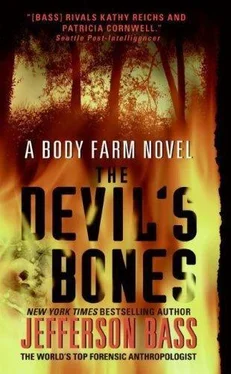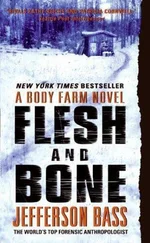Jefferson Bass - The Devil's Bones
Здесь есть возможность читать онлайн «Jefferson Bass - The Devil's Bones» весь текст электронной книги совершенно бесплатно (целиком полную версию без сокращений). В некоторых случаях можно слушать аудио, скачать через торрент в формате fb2 и присутствует краткое содержание. Год выпуска: 2009, Жанр: Детектив, на английском языке. Описание произведения, (предисловие) а так же отзывы посетителей доступны на портале библиотеки ЛибКат.
- Название:The Devil's Bones
- Автор:
- Жанр:
- Год:2009
- ISBN:нет данных
- Рейтинг книги:4 / 5. Голосов: 1
-
Избранное:Добавить в избранное
- Отзывы:
-
Ваша оценка:
- 80
- 1
- 2
- 3
- 4
- 5
The Devil's Bones: краткое содержание, описание и аннотация
Предлагаем к чтению аннотацию, описание, краткое содержание или предисловие (зависит от того, что написал сам автор книги «The Devil's Bones»). Если вы не нашли необходимую информацию о книге — напишите в комментариях, мы постараемся отыскать её.
The Devil's Bones — читать онлайн бесплатно полную книгу (весь текст) целиком
Ниже представлен текст книги, разбитый по страницам. Система сохранения места последней прочитанной страницы, позволяет с удобством читать онлайн бесплатно книгу «The Devil's Bones», без необходимости каждый раз заново искать на чём Вы остановились. Поставьте закладку, и сможете в любой момент перейти на страницу, на которой закончили чтение.
Интервал:
Закладка:
Five minutes later Art, Miranda, and I surveyed one another glumly across my desk beneath Neyland Stadium. “How did this happen?” I said. “Where? When? With his trial coming up, I’d have thought Hamilton would be watched like a hawk.”
Art sighed. “You and me both.”
“Was he in the Knox County Detention Center? Hell, they’ve got cameras by the hundreds out there-I don’t see how a prisoner could pick his nose without three cameras recording the boogers for posterity.”
He shook his head. “The reason we hustled you away from the Farm so fast is that he was only a stone’s throw away when he escaped.” I stared at Art uncomprehendingly. “He was in the ER at UT Hospital. They’d rushed him there after he went into convulsions,” Art said. “Or appeared to go into convulsions. As they were wheeling him into the ER, he jumped off the gurney and ran into a stairwell.”
“Damn it,” I said, “that’s the worst possible place for him to get loose. He knows every nook and cranny of that hospital. If they didn’t have it locked down in sixty seconds, he could have taken a hundred ways out.”
“They didn’t have it locked down in sixty seconds,” Art said.
I didn’t need him to tell me that. The chorus of helicopter rotors and police sirens told me Hamilton had gotten away. What I didn’t know was where he’d go and what he’d do: lie low, slip away, or try again to kill me?
TWENTY-FOUR HOURSlater, I was still in shock. I’d spent a bad night, followed by a dismal day and an even more wretched night. Every sudden noise made me jump, and the only thing worse than the sound of the phone ringing was the sound of it not ringing-the sound of Hamilton slipping silently away.
A security camera showed that Hamilton had ducked out through the back door of the Forensic Center only minutes after leaping off the gurney. In fact, he was already outside before the first KPD units were dispatched toward the hospital. Somewhere between the ER and the Forensic Center’s exit, he’d tugged on a pair of scrubs and a surgical mask. One of the pathology residents later told police that he thought he’d glimpsed Hamilton in the hallway, but he’d dismissed the notion, since he knew-or thought he knew-that Hamilton was in custody.
Once beyond the loading-dock camera’s field of view, Hamilton had vanished completely. It was possible he’d stowed away in the back of a linen truck or one of the dozens of other service vehicles entering and exiting the hospital complex daily. It was also possible he’d simply walked across a parking lot and slipped into the woods that bordered the grounds on the south and the east. Two days of searching-by tracking dogs, by helicopters, and by dozens of KPD officers, Knox County deputies, and TBI agents-had failed to turn up any leads.
Hamilton’s escape was the lead story in the Knoxville News Sentinel and on every local TV station. His picture and Jess’s and mine were prominently featured, and my house was once more besieged with reporters clamoring for sound bites describing how it felt to know that the man who’d killed Jess and tried to kill me was on the loose. The only consolation to the media frenzy was that if Hamilton showed up within a mile of my house, he’d be captured instantly, at least on videotape, by several news crews. The two days after his escape were among my life’s lowest points-surpassed only by Kathleen’s death, Jess’s murder, and my arrest.
The third day I rose from the dead, or at least from the deadly paralysis of spirit that had gripped me. The only way to get my mind off Hamilton, I realized that day, was to get it on something else. One such something, I decided, could be unraveling Burt DeVriess’s questions about his Aunt Jean’s cremation.
I called Helen Taylor at East Tennessee Cremation and apologized for standing her up two days before. “If you’re still willing to show me around, I’d appreciate it, but if you don’t want to bother at this point, I understand.”
She assured me she’d not taken offense-she’d seen me on the news after Hamilton escaped-and invited me to come out as soon as I could.
“Is thirty minutes too soon?” I asked.
“Thirty minutes is fine,” she said.
I resumed the journey I’d begun two days before.
East Tennessee Cremation occupied a low, modest building on a grassy corner at the Rockford industrial park’s entrance. Facing it, across the street, was a prefab metal warehouse identified as S AND S SERVICES. The crematorium was no bigger than a two-car garage and not much fancier, the owners apparently seeing no need to indulge in the frilly sentiment or veneered stateliness of funeral homes. I liked the unpretentious plainness-it was fitting, I decided, for a place that took in dead bodies, laid them in an incinerator of sorts, and burned them down to inorganic minerals. The building had a low L on one side, which housed an office with a glass door and double-hung windows. The business part of the building-the part in the higher, cinder-block portion-had a big roll-up garage door on the front end and two steel exhaust stacks on the other. The building had no sign of any kind; it was the stacks-their tops a swirl of bluish black that bespoke extreme heat-that told me I’d found the crematorium.
I knocked on the glass storm door, but I didn’t get an answer, so I peered inside. The office looked vacant. The door was unlocked, so I stuck my head in and called, “Hello? Ms. Taylor?”
From around a corner, in the garage-looking part of the building, I heard a muffled female voice say, “I’ll be right there.”
A pleasant, fiftyish woman emerged. Dressed in a gray pantsuit and black pumps, she would have looked at home in a bank or real-estate office, except for the work gloves she wore-the leather-and-canvas kind favored by carpenters and farmers. She took off one glove and held out a hand.
“You must be Dr. Brockton,” she said. “I’m Helen Taylor. Sorry to keep you waiting.”
“I kept you waiting for two days,” I said, “so you’ve still got a ways to go before you need to apologize. Thanks for agreeing to give me a look around.” I shook her hand. She had a firm grip and an open, direct gaze that I liked. For some reason, maybe because so many funeral directors tended to look deferentially downward, I hadn’t expected someone so forthright.
Helen had started out more than twenty years earlier working as a secretary in the office of a company that made metal cemetery vaults. Several years later, when the owner of the vault company branched out and opened a crematorium, he trained Helen to run it. After serving a two-year apprenticeship, she took the examination to become a licensed funeral director. Although she passed the exam with flying colors, the licensing board turned her down-they’d never licensed a female funeral director, nor anyone who’d apprenticed at an independent crematorium. After two years of training, Helen wasn’t willing to take rejection lying down. She hired an attorney, who threatened to sue the licensing board for discrimination. A few weeks later, she received a letter containing her funeral director’s license.
In its first year of operation, the crematorium had burned only four bodies, leaving her plenty of time for secretarial work. This year, she said, the number would top four hundred. Business was so good, in fact, that the crematorium was beginning an enormous expansion. She raised the blinds behind her desk and pointed out the window at a fresh excavation and enormous concrete slab. Within a year, she told me, they’d be moving to a new building five times this size. It would be equipped with a chapel for services, a viewing window, and a remote-control ignition switch, so a family member could push a button to start the cremation. The old building would remain a crematorium, but it would shift from cremating humans to cremating pets, a business that was growing by leaps and bounds. She pulled out a binder filled with architectural drawings and floor plans of the new building. I noticed it would have three furnaces rather than just two; I also noticed a large room labeled COOLER, which I asked about. The cooler would be able to hold up to sixteen bodies, she told me proudly.
Читать дальшеИнтервал:
Закладка:
Похожие книги на «The Devil's Bones»
Представляем Вашему вниманию похожие книги на «The Devil's Bones» списком для выбора. Мы отобрали схожую по названию и смыслу литературу в надежде предоставить читателям больше вариантов отыскать новые, интересные, ещё непрочитанные произведения.
Обсуждение, отзывы о книге «The Devil's Bones» и просто собственные мнения читателей. Оставьте ваши комментарии, напишите, что Вы думаете о произведении, его смысле или главных героях. Укажите что конкретно понравилось, а что нет, и почему Вы так считаете.












